Exercises (1559)
Frontal and lateral raising and lowering of the arms while standing ► front raise/lateral raise (side raise)
Power
Individual work
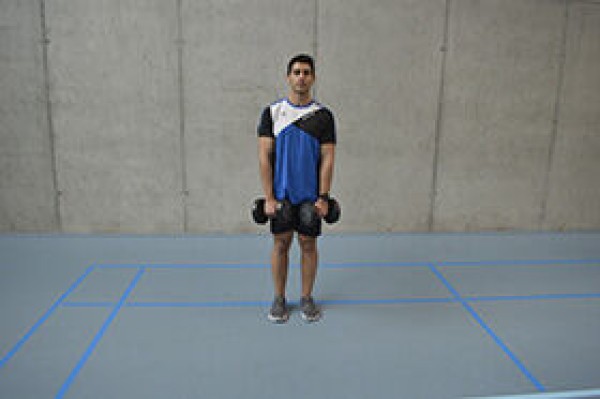


Stand upright, arms extended downwards in front of your body with the dumbbells in your hands (hanging), the backs of your hands pointing forwards (overhand grip), raise your arms in the direction you are facing until they are horizontal (shoulder height, backs of hands pointing upwards), spread your arms out to the side from the holding position ("T" position), bring your arms back together in front of your head and lower them back to the starting position.
Attention:
Keep your back straight (possibly back against a wall), actively tense your core.
Lighten:
Less weight.
Harden:
More weight.
2 dumbbells
Frontal and lateral raising and lowering of the arms in prone position ► front raise/lateral raise (side raise)
Power
Individual work
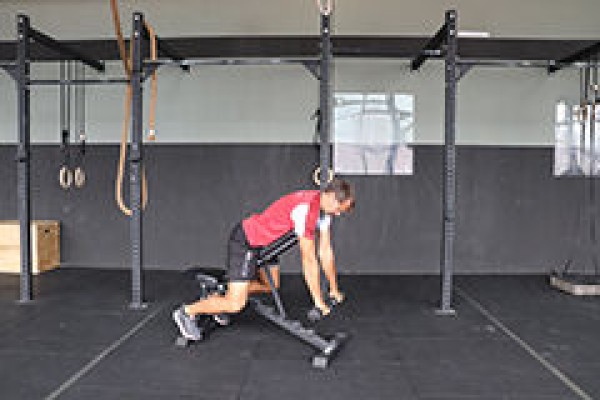
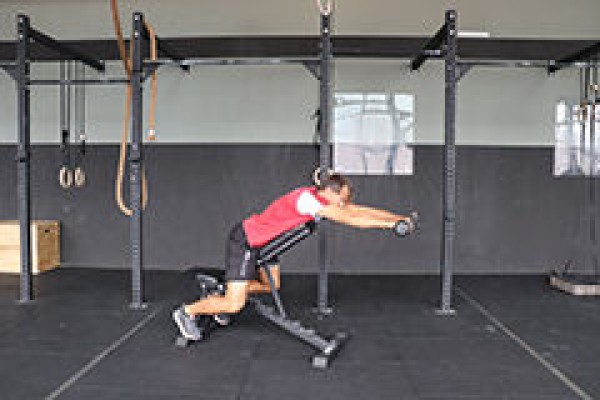
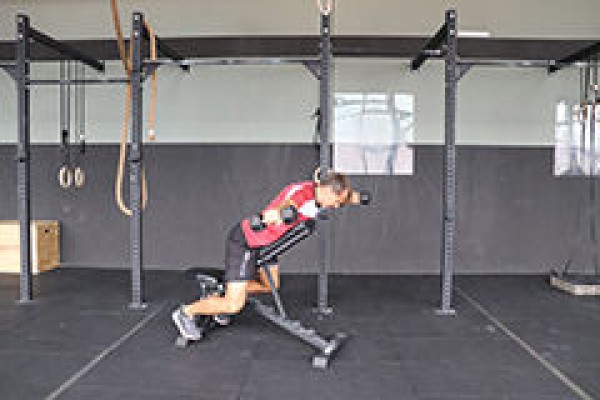
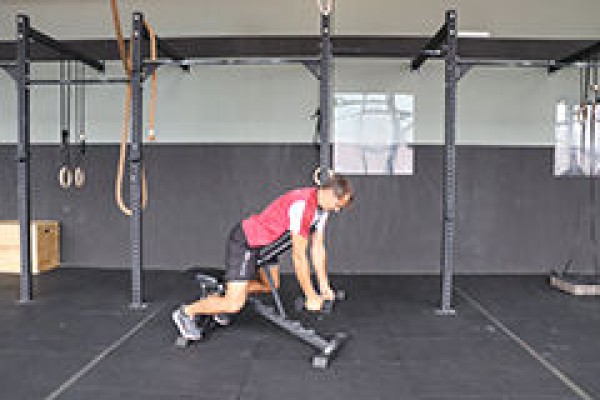
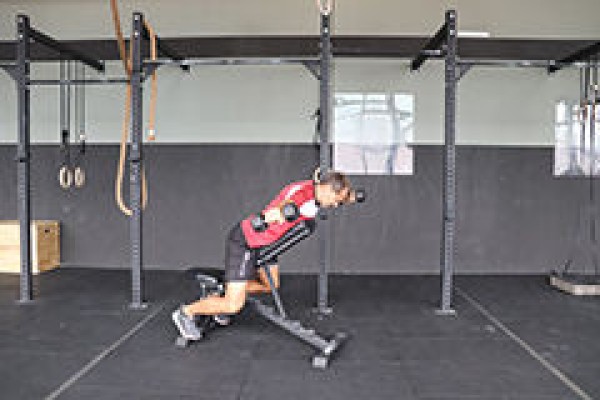
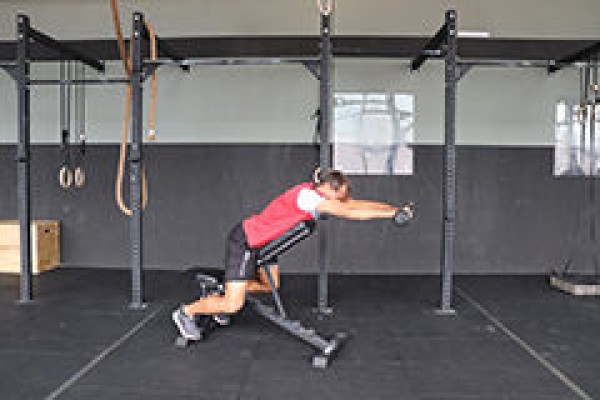

Stomach position on the inclined flat bench, arms almost stretched out towards the floor (hanging), grasp a dumbbell with each hand (overhand grip, palms facing forwards). In one movement, raise your arms frontally to approximately chin height (palms facing down), spread your arms out to the side (T-position, arms parallel to the floor), then bring your arms to the floor (palms facing your body). Now perform the movement in reverse order: Raise your arms sideways, bring them together in front of your head, then lower your arms to the floor back to the starting position.
Attention:
Despite the reduced possibility of falsification due to the upper body being fixed on the incline bench, ensure that the movement is performed slowly and evenly (jerking the weights upwards always leads to poorer training results and increases the risk of injury).
Lighten:
Less weight.
Harden:
More weight.
1 flat bench
2 dumbbells
Pulling an object towards you while standing ► row battle rope
Power
Individual work

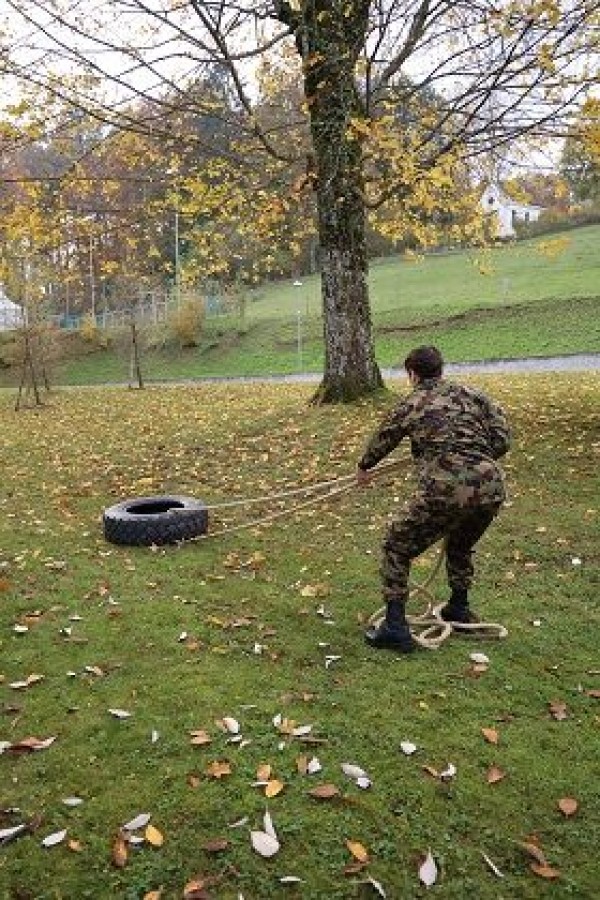

Stand shoulder-width apart at the ends of the rope (facing the tyre), bend your knees slightly, grasp both ends of the rope with your hands and pull the tyre attached to the rope towards you. Once you have pulled the tyre up to your feet, sprint to the other side until the rope is taut again to restart the exercise.
Attention:
Keep your back straight.
Lighten:
Less weight/load.
Harden:
More weight/greater load.
1 rope/rope
1 tyre (DURO)
1 tyre (PUCH) ► Make the exercise easier
1 tyre (10DM) ► Make the exercise more difficult (additional weight)
Gehen ► suitcase carry
Power
Individual work
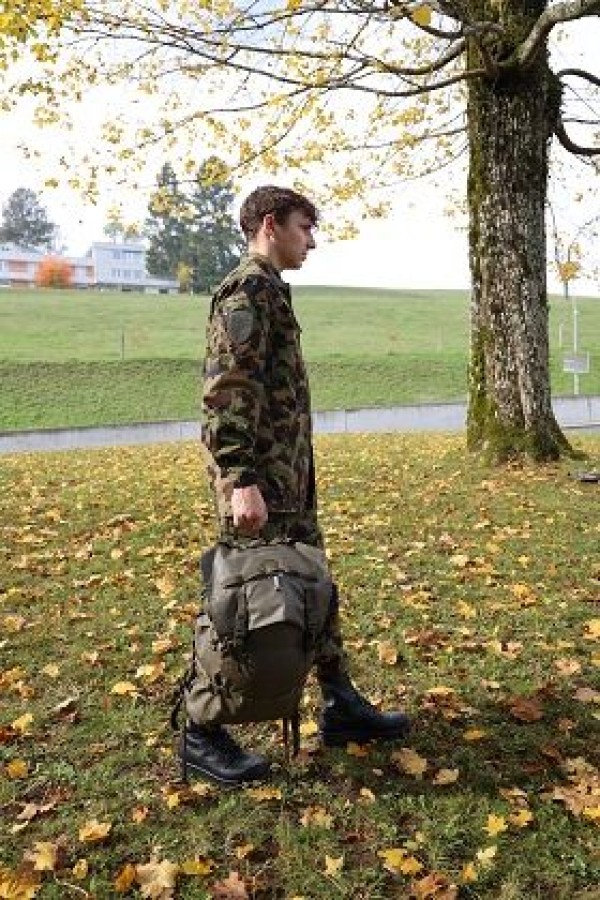
Grab an object (e.g. sandbag or rucksack) with each hand, keep your arms hanging next to your body and transport objects over a certain distance.
Attention:
Keep your back straight and your pelvis stable with every step, keep your shoulders fixed (press towards your hips).
Lighten:
Less weight/load.
Harden:
More weight/greater load.
2 combat backpacks/sandbags/dumbbells (medium weight)
2 combat backpacks/sandbags/dumbbells (light) ► Make the exercise easier
2 combat backpacks/sandbags/dumbbells (heavy) ► Make the exercise more difficult
Gehen ► suitcase carry
Power
Individual work

Take an object in one hand (e.g. military equipment or a combat rucksack), let your arms hang at the side of your body and carry the object over a certain distance.
Attention:
Keep your back straight, your pelvis stable with every step and your shoulders fixed (lower towards your hips).
Variant:
Hold an object in both hands.
Lighten:
Equipment approx. 5kg
Harden:
Heavier equipment (add 3 litres of water to the backpack)
Material per participant: Tenue CNK 420, 2 x material of approx. 5kg/10kg/15kg
Additional material: 2 fanjons, 2 PET bottles (1.5l)
Walking on an elevation
Power
Individual work
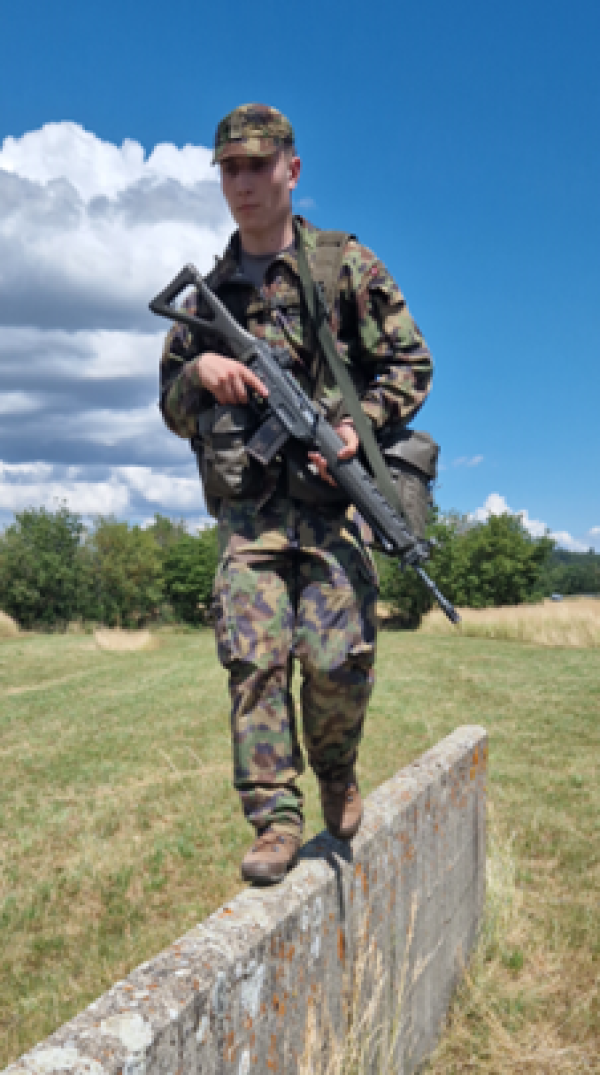
In the CNG 428 tenue, step onto a raised area (e.g. wall); start alternately with the left or right leg (support from a team mate is possible). Run back and forth without stepping off/losing your balance.
Lighten:
Without equipment;
Wider wall.
Harden:
With combat backpack;
Narrower wall.
Material per participant: Tenue CNG 428
Additional material: 1 wall/ruins (station 6 of the outdoor obstacle course)
Cross your hand over your bent leg while standing
Power
Individual work
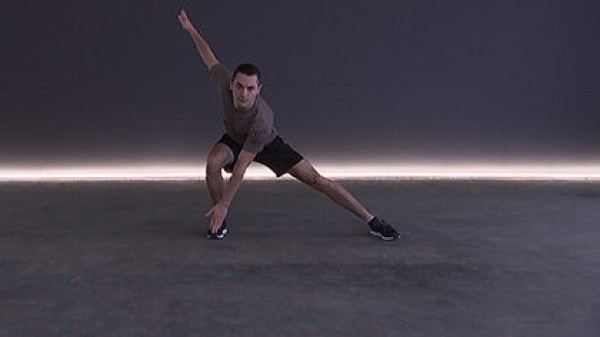
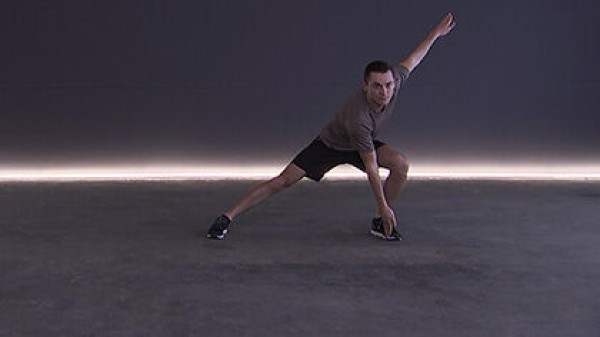
Bend your legs in a standing position, upper body tilted forwards, bend one leg alternately and touch the tip of each foot with your hand crosswise.
Attention:
Knees always remain behind the tips of the feet and point forwards.
Lighten:
Lower your upper body less (touch your knees instead of the top of your feet).
Harden:
Add weight to your arms and/or legs.
2-4 weight cuffs/2 weight balls to make the exercise more difficult (additional weight)
Bring your hand crosswise to your knee in push-up position ► knee touch / knee tap push up position
Power
Individual work
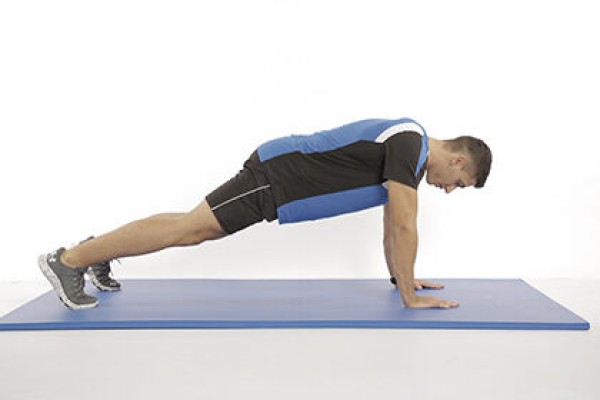
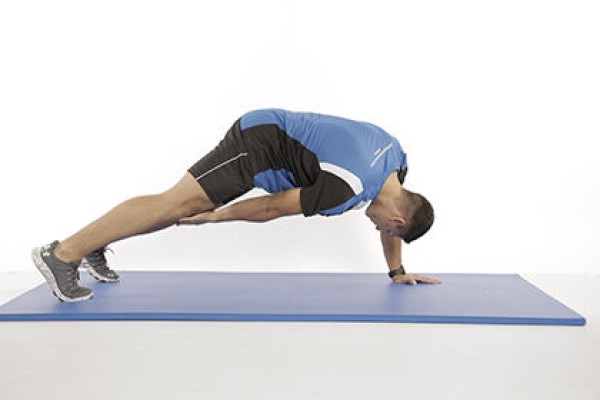
Push-up position (high support, face/gaze downwards), buttocks slightly raised, touch the opposite foot or knee with one hand, without lifting the legs. Switch sides after each exercise.
Attention:
Keep your upper body stable (tense your stomach).
Lighten:
Just hold the basic position (push-up position).
Harden:
Additional weight on the arms; unstable support.
2 weight cuffs ► making the exercise more difficult (additional weight)
2 balance cushions/1 balance board ► making the exercise more difficult (unstable base)
Bring your hand crosswise to your shoulder in push-up position ► Shoulder tap push up position
Power
Individual work
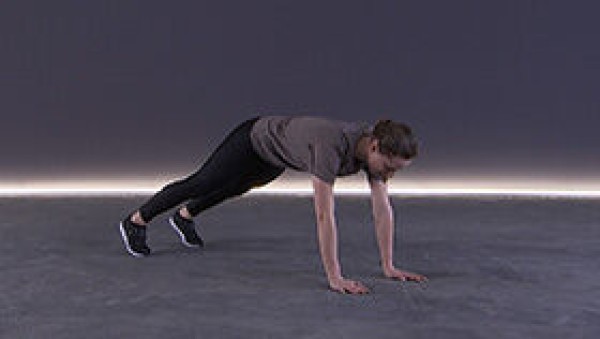

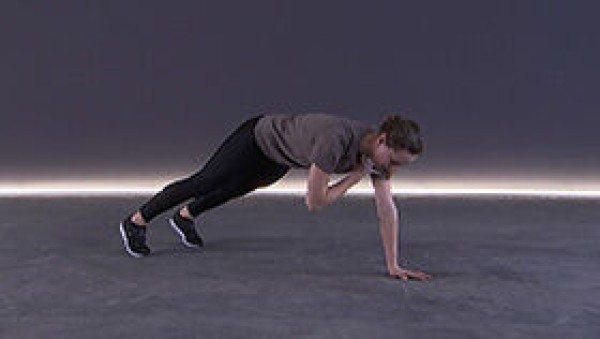
Push-up position (high support, face/look down), bring one hand crosswise to the shoulder. Switch sides after each exercise.
Attention:
Head, torso, hips and knees practically form a line (do not stretch your buttocks upwards or let them sag, tense your stomach).
Lighten:
Just hold the basic position (push-up position); place your knees on the floor.
Harden:
Additional weight (on your back or arms); unstable base.
2 weight cuffs/1 weight vest/weight disc/sandbag ► Make the exercise more difficult (additional weight)
1-2 balance cushions/1 balance board ► Make the exercise more difficult (unstable surface)
Bring hand and foot together crosswise while standing
Power
Individual work
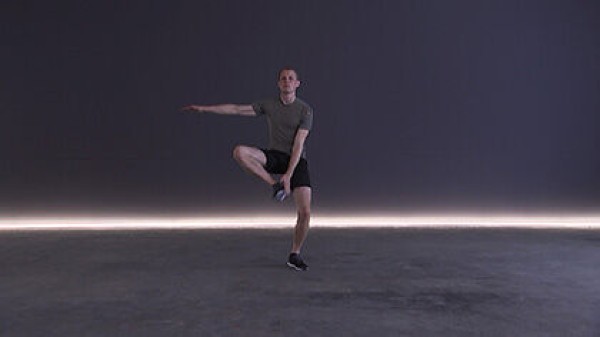

Stand upright on the balls of your feet, shoulder-width apart, alternately lift one foot while hopping and touch it with your hand crosswise in front of your body at hip level.
Attention:
Do not put your heels down completely (keep jumping on your toes).
Lighten:
Lift your foot less (possibly without touching it with your hand).
Harden:
Lift your foot higher; additional weight (on your legs).
2 weight cuffs/1 weight waistcoat ► Make the exercise more difficult (additional weight)
Bring hand and foot together crosswise in four-footed stance backwards alternating ► toe tap / toe touch
Power
Individual work
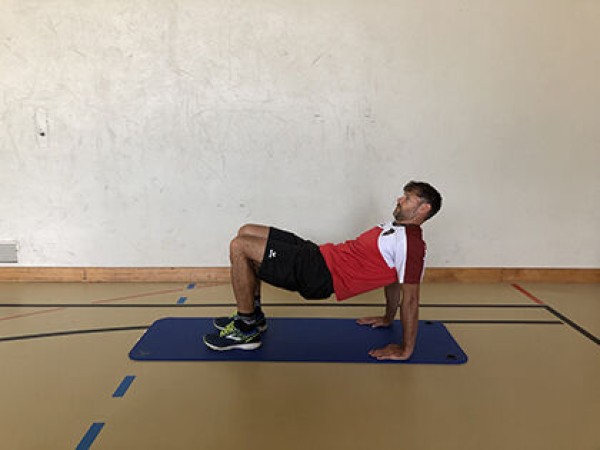

Inverted four-foot stance (chest pointing upwards, body supported on hands and feet, fingertips pointing forwards). Raise one arm and one leg crosswise and bring the hand and foot together. Switch sides after each exercise.
Lighten:
Just hold the position or raise your arm and leg only slightly (without bringing your hand and foot together).
Harden:
Additional weight.
2-4 weight cuffs/1 weight waistcoat ► Make the exercise more difficult (additional weight)
Bring hand and foot together crosswise in push-up position ► mountain climber toe touch / toe tap (climber tap)
Power
Individual work
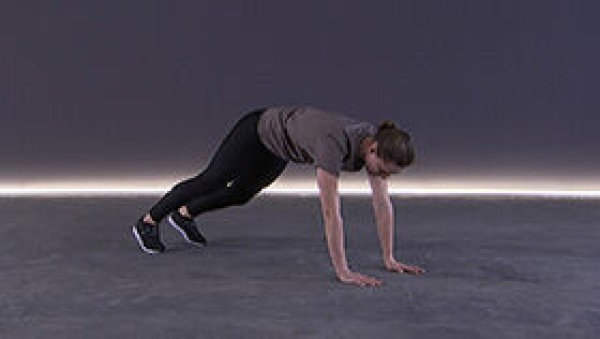

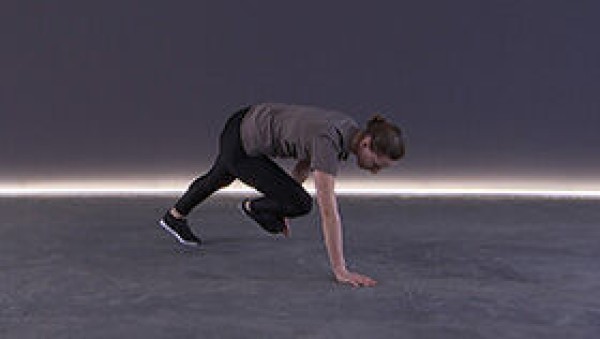
Push-up position (high support, face/gaze downwards), bring one hand and one foot together crosswise, keeping the arm stretched and the leg bent (knee approximately at chest height). Switch sides after each exercise.
Attention:
Keep your upper body as stable as possible (tense your stomach).
Lighten:
Just hold the basic position (push-up position).
Harden:
Additional weight on arms and legs; unstable base.
Variant:
Cross your elbows to your knees.
2-4 weight cuffs ► Make the exercise more difficult (additional weight)
1-2 balance cushions ► Make the exercise more difficult (unstable base)
Bring hand and knee together in lateral forearm support (left) ► knee raise lateral pillar bridge / side bridge
Power
Individual work
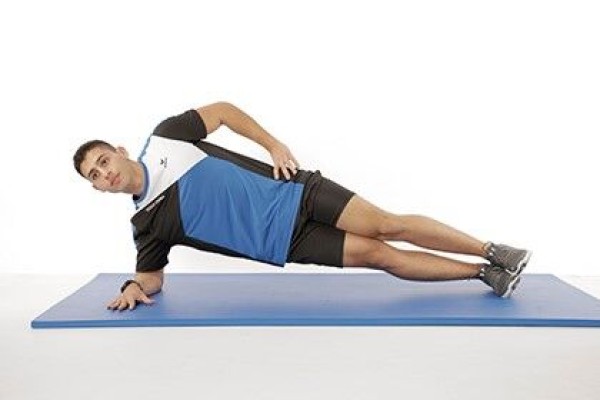
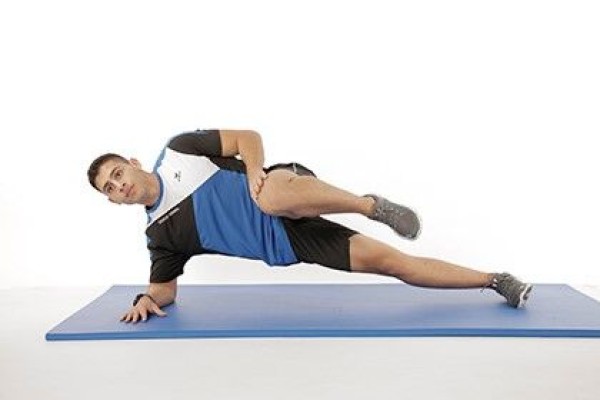
Side support on the (right) forearm (possibly on a wall for the correct straight position), bring the upper hand (or elbow) and upper knee together (approximately at the level of the navel) and back to the starting position.
Attention:
Head, torso, hips and knees practically form a line (pelvis does not tilt backwards or forwards), keep the shoulder above the elbow.
Lighten:
Place the lower knee on the floor; bend the leg less; only hold the position.
Harden:
Additional weight for the arm and/or training leg; unstable base (possible for both the supporting arm and the supporting leg).
2 weight cuffs/1 weight ball/dumbbell ► Make the exercise more difficult (additional weight)
1 ball/1-2 balance cushions/1 balance board ► Make the exercise more difficult (unstable surface)
Bring hand and knee together in lateral forearm support (right) ► knee raise lateral pillar bridge / side bridge
Power
Individual work
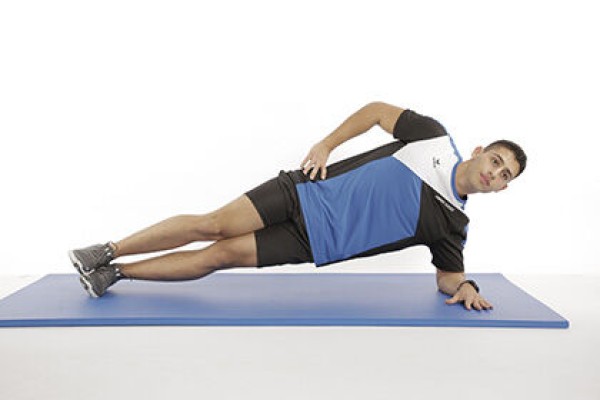
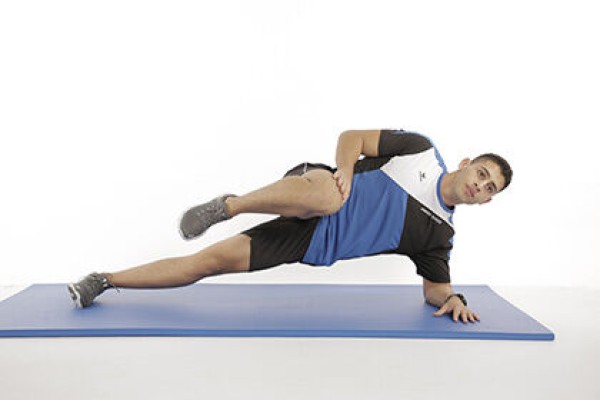
Side support on the (left) forearm (possibly on a wall for the correct straight position), bring the upper hand (or elbow) and upper knee together (approximately at the level of the navel) and back to the starting position.
Attention:
Head, torso, hips and knees practically form a line (pelvis does not tilt backwards or forwards), keep the shoulder above the elbow.
Lighten:
Place the lower knee on the floor; bend the leg less; only hold the position.
Harden:
Additional weight for the arm and/or training leg; unstable base (possible for both the supporting arm and the supporting leg).
2 weight cuffs/1 weight ball/dumbbell ► Make the exercise more difficult (additional weight)
1 ball/1-2 balance cushions/1 balance board ► Make the exercise more difficult (unstable surface)
Move hand to heel in supine position alternating ► heel touch / heel tap
Power
Individual work
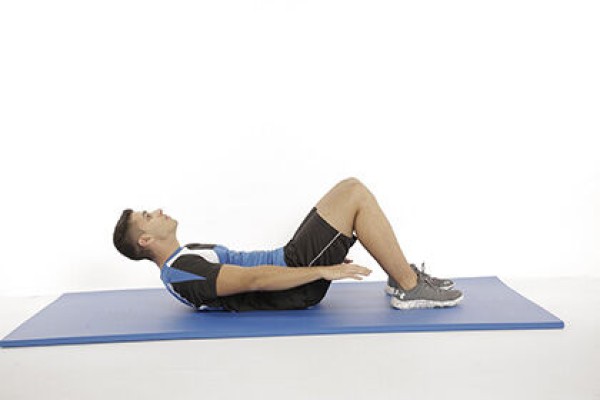
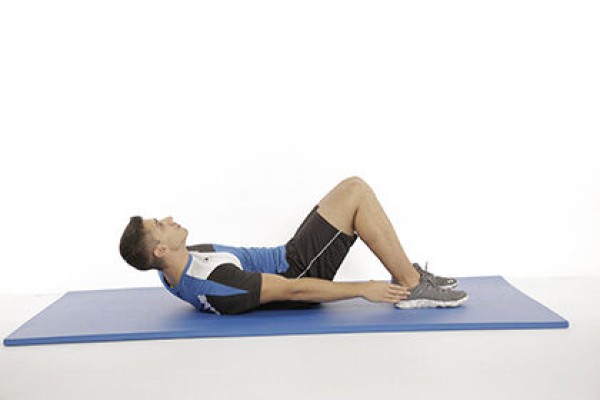
Lie on your back with your legs bent (feet also bent or flat on the floor), arms outstretched and slightly raised next to your body, hands alternately on your left and right heels (tilt your upper body sideways).
Attention:
Do not lower your shoulders completely (constant tension).
Lighten:
Lower your hands forward; only hold the centre position with your upper body raised.
Harden:
Hold additional weight on your arms/in your hands.
2 weight cuffs/weight balls/dumbbells ► Make the exercise more difficult (additional weight)
Bring hand to shoulder crosswise in push-up position alternating ► biceps curl push up position
Power
Individual work
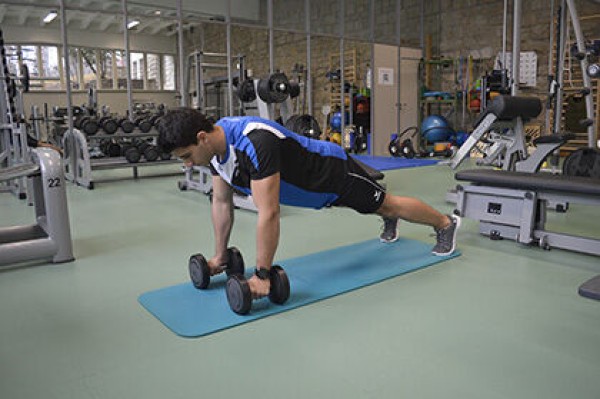
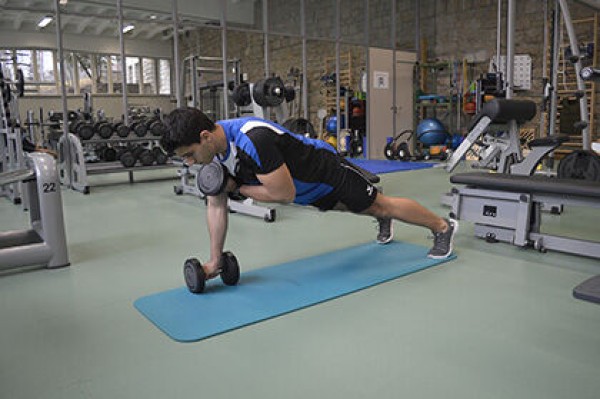
In the push-up position, hold a dumbbell in each hand and alternately move one dumbbell to the opposite shoulder by bending one arm (return to the push-up position in between).
Caution:
Keep the torso stable and don't let it sag (actively tense the torso muscles).
Lighten:
Less weight.
Harden:
More weight; additional weight (on the back).
Variant:
Combine exercise with push-ups (i.e. bend and stretch left arm, push-up, bend and stretch right arm, push-up, etc.).
2 dumbbells
1 weight vest/weight disc/sandbag ► Make the exercise more difficult (additional weight)
Bring your hands to your feet from the push-up position ► hand walk
Power
Individual work
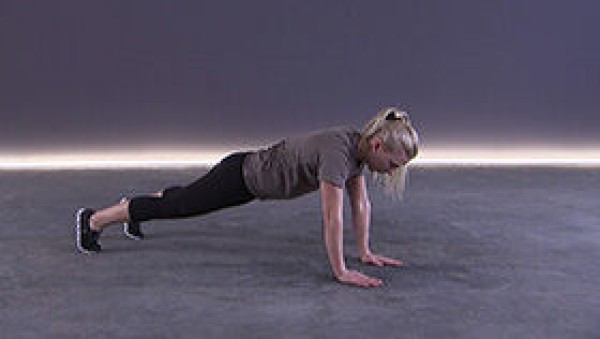
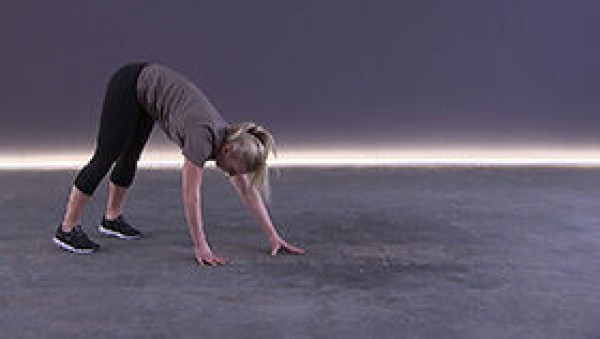

Push-up position (high support, face/look down), walk backwards with your hands and slowly straighten up until you can touch your feet, bring your hands forwards back to the starting position (possibly even further than head height).
Attention:
Do not let your upper body sag (actively tense your core), do not wiggle your hips back and forth.
Lighten:
Do not move your hands so far backwards/forwards.
Harden:
Stable surface (for your feet).
1 balance cushion/balance board ► Make the exercise more difficult (unstable surface)
Bring your hands to your shoulder while standing ► shoulder tap
Power
Individual work
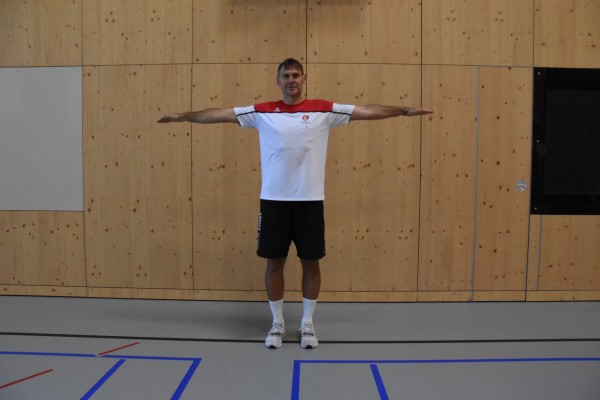
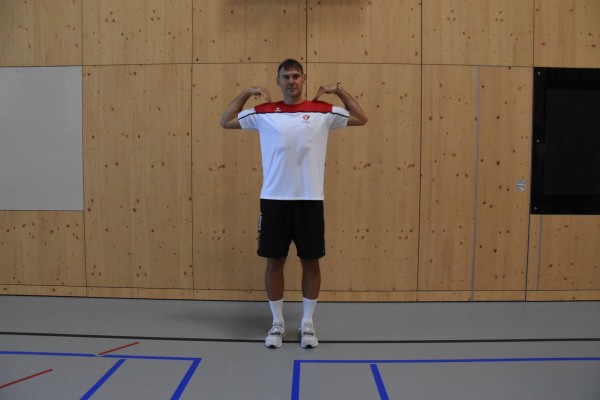
Stand upright with your feet shoulder-width apart, arms stretched out to the side (shoulder height - palms facing the floor), bend your arms and touch your shoulders with your hands, stretch your arms back to the starting position.
Harden:
Hold additional weight on your arms or in your hands.
Variant:
Arms held out in front instead of stretched out to the side. A combination of arm positions is also possible: after touching the shoulders, extend the arms alternately frontally or laterally.
2 weight cuffs/weight balls/dumbbells ► make the exercise more difficult (additional weight)
Raise your arms alternately while standing
Power
Individual work
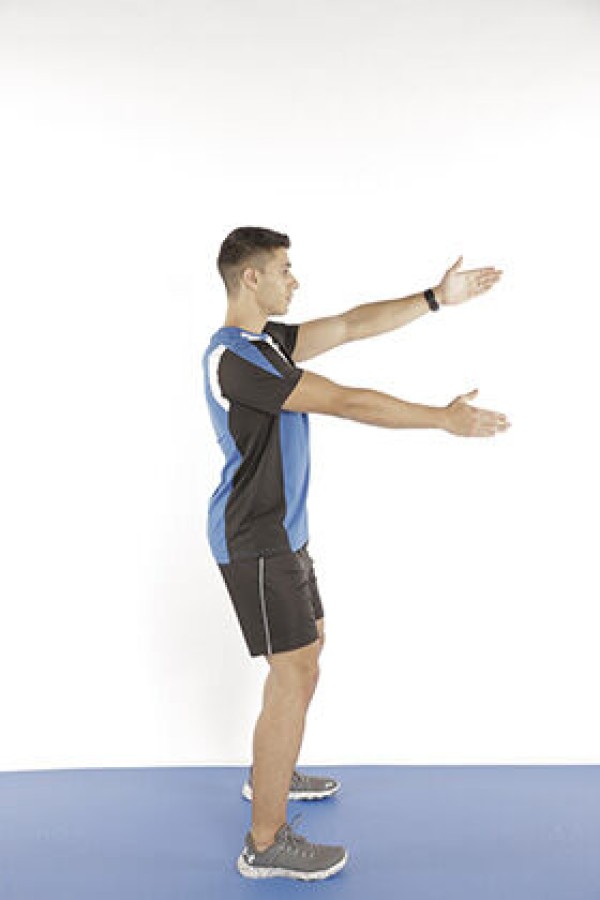
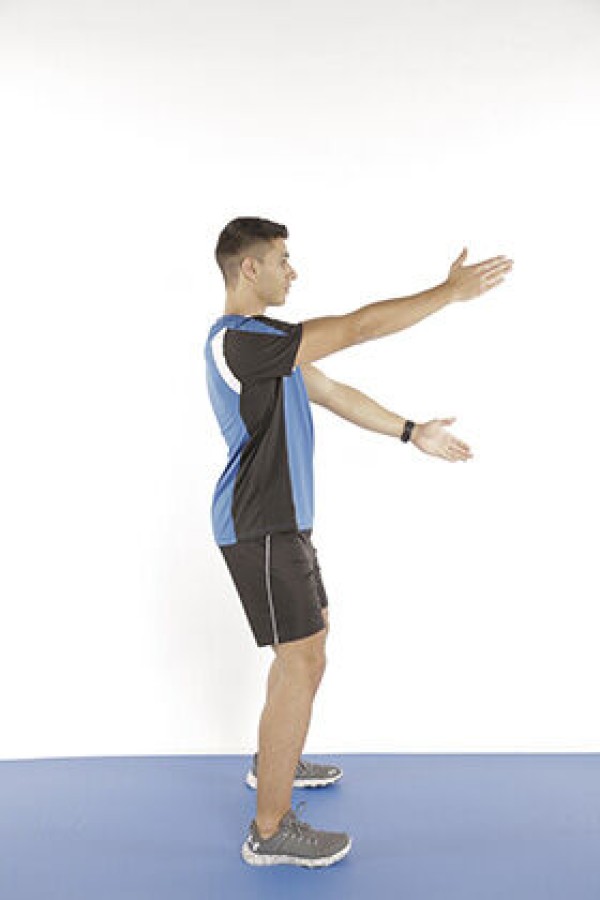
Exercise description:
Stand upright, arms outstretched in front of you, palms facing inwards, move arms up and down in a staggered manner (height of the crown of the head and chest).
Attention: Always keep arms almost fully extended and never lower than chest height.
Lighten: Extend arms less.
Lighten: Hold additional weight on the arms or with both hands.
2 weight cuffs/weight balls/dumbbells/1 weight disc ► Make the exercise more difficult (additional weight)
Alternating squat and kneeling position
Power
Individual work
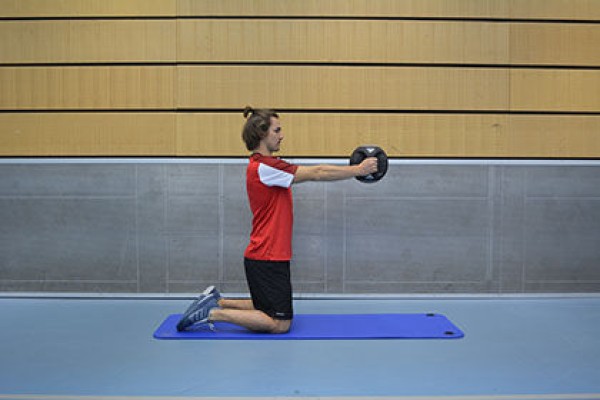
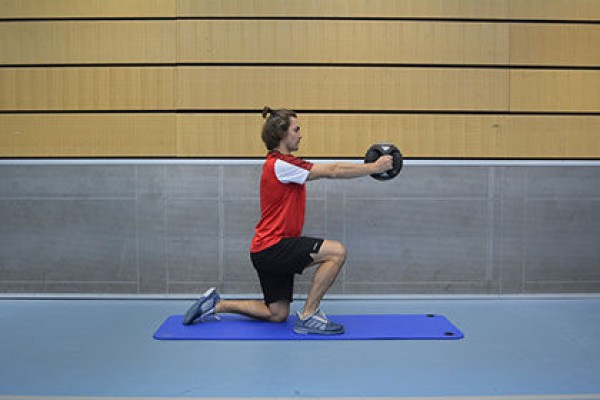
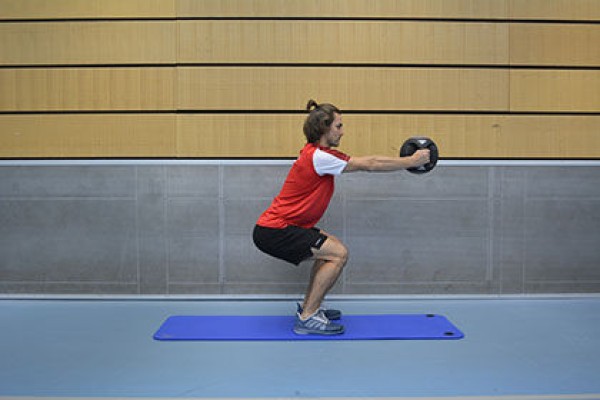
While kneeling, hold a ball with your arms stretched out in front of you (chest height), upper body upright, toes pointing towards the floor, raise one leg at a time from the starting position to get into a deep squat (place foot flat on the floor, maintain an angle of approximately 90 degrees in the knee joint - end position of a squat), then return to the kneeling position.
Attention:
The medicine ball practically does not move and is always held at the same height. Accordingly, you really need to make sure that you adopt a low squatting position.
Lighten:
Arms in front without additional weight; more upright squatting position (greater angle in the knee joint).
1 (medicine) ball
Jumping in place (rope skipping double jump) ► double under
Power
Individual work

Stand upright on the balls of your feet with your feet shoulder-width apart, holding a skipping rope in your hands. Jump steadily in place and simultaneously swing the rope (under your feet and overhead), with the rope making two complete rotations during one jump (double jump).
Attention:
Do not put your heels down (jump on the balls of your feet/tips of your toes). Keep your upper body upright (tense your core). The rope is accelerated from the wrists (very fast circling) so that two rope rotations are possible during a jump.
Lighten:
Simple jumps (slower swinging - one rope rotation per jump).
Harden:
Additional weight (on the feet).
Variant I:
Pull the tips of your feet towards your knees (bend your feet) with each jump.
Note:
Two single jumps replace one double jump (1 double under = 2 x single rope jumps) in training. Instead of jumping rope, the knee lift (skipping) is often chosen as a substitute (no material required).
1 skipping rope
2 weight cuffs/1 weight waistcoat ► Make the exercise more difficult (additional weight)
Jumping in place (rope skipping double jump) ► double under (30sec)
Power
Individual work

Stand upright on the balls of your feet with your feet shoulder-width apart, holding a skipping rope in your hands. Jump steadily in place and simultaneously swing the rope (under your feet and overhead), with the rope making two complete rotations during one jump (double jump).
Attention:
Do not put your heels down (jump on the balls of your feet/tips of your toes). Keep your upper body upright (tense your core). The rope is accelerated from the wrists (very fast circling) so that two rope rotations are possible during a jump.
Lighten:
Simple jumps (slower swinging - one rope rotation per jump).
Harden:
Additional weight (on the feet).
Variant I:
Pull the tips of your feet towards your knees (bend your feet) with each jump.
Note:
Two single jumps replace one double jump (1 double under = 2 x single rope jumps) in training. Instead of jumping rope, the knee lift (skipping) is often chosen as a substitute (no material required).
1 skipping rope
2 weight cuffs/1 weight waistcoat ► Make the exercise more difficult (additional weight)
Jumping in place (jumping rope)
Power
Individual work
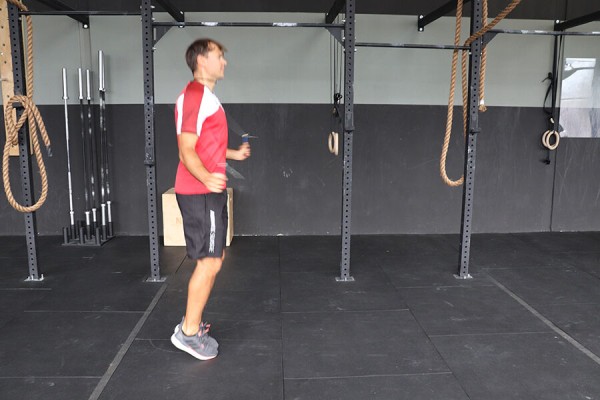
Stand upright on the balls of your feet with your feet shoulder-width apart, holding a skipping rope in your hands. Jump steadily in place and simultaneously swing the rope (under your feet and overhead).
Attention:
Without putting your heels down (jumping on the balls of your feet/tips of your toes). Keep your upper body upright (tense your core).
Lighten:
Lower intensity (slower swinging).
Harden:
Higher intensity (very fast jumping); additional weight (on the feet).
Variant I:
Pull the tips of your feet towards your knees with each jump (bend your feet).
Variant II:
Integrate jump shapes: Double jumps, crossing arms, alternating left/right heel taps on the floor, straddle jumps, jumping in step position, alternating jumps, etc.
Note:
Two single jumps replace one double jump in training (1 double under = 2 x single rope jumps). Instead of jumping rope, the knee lift (skipping) is often chosen as a substitute (no material required).
1 skipping rope
2 weight cuffs/1 weight waistcoat ► Make the exercise more difficult (additional weight)
Jumping in place (jumping rope) (30sec)
Power
Individual work

Stand upright on the balls of your feet with your feet shoulder-width apart, holding a skipping rope in your hands. Jump steadily in place and simultaneously swing the rope (under your feet and overhead).
Attention:
Without putting your heels down (jumping on the balls of your feet/tips of your toes). Keep your upper body upright (tense your core).
Lighten:
Lower intensity (slower swinging).
Harden:
Higher intensity (very fast jumping); additional weight (on the feet).
Variant I:
Pull the tips of your feet towards your knees with each jump (bend your feet).
Variant II:
Integrate jump shapes: Double jumps, crossing arms, alternating left/right heel taps on the floor, straddle jumps, jumping in step position, alternating jumps, etc.
Note:
Two single jumps replace one double jump in training (1 double under = 2 x single rope jumps). Instead of jumping rope, the knee lift (skipping) is often chosen as a substitute (no material required).
1 skipping rope
2 weight cuffs/1 weight waistcoat ► Make the exercise more difficult (additional weight)
Bounce in place ► hop
Power
Individual work
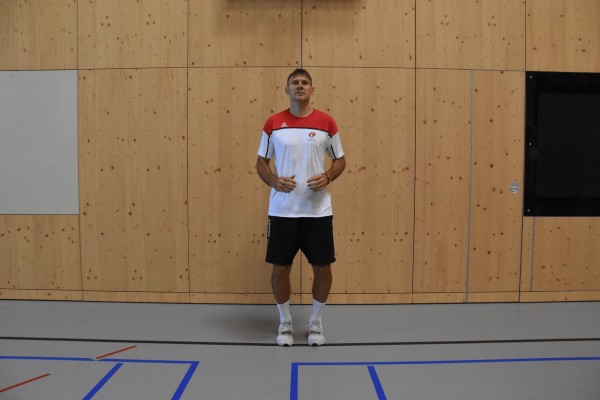
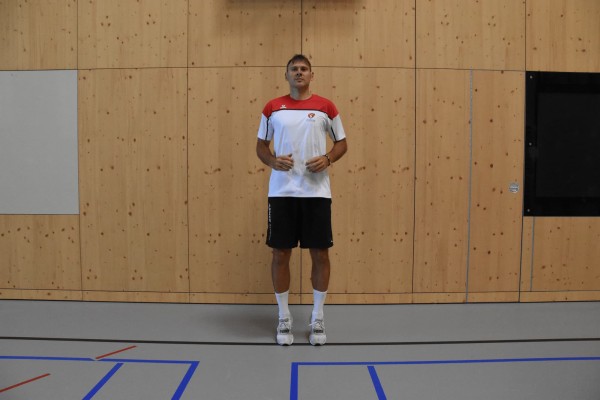
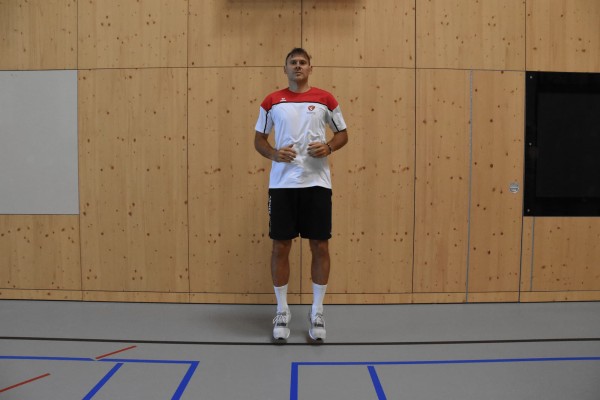
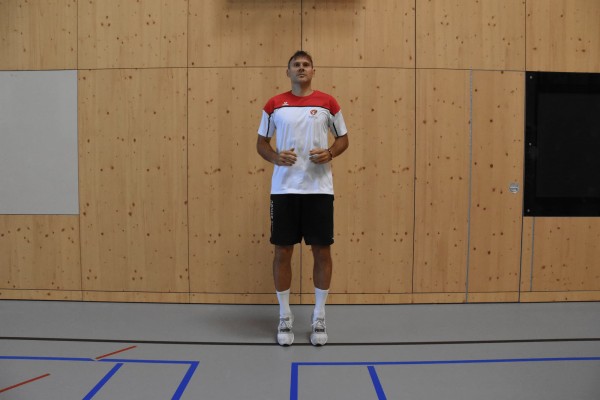
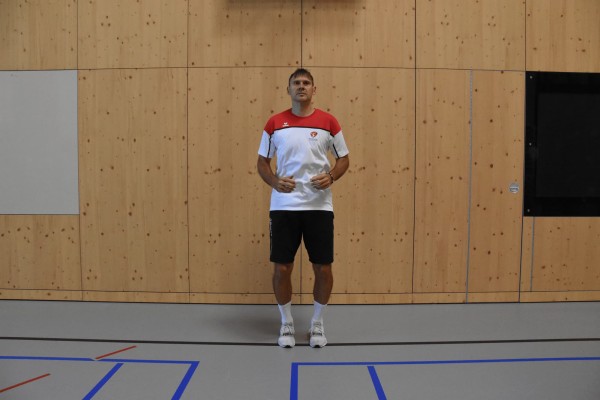
Stand upright on the balls of your feet with your knees slightly bent and your arms bent in front of your body or supported on your hips. Bounce steadily in place (fast frequency) without putting your heels down (bounce on your toes).
Attention:
Keep your upper body upright (keep your core tensed).
Lighten:
Smaller/less intense jumps.
Harden:
Larger/intensive jumps; additional weight (on the chest/shoulders, hold in the hands, hold in front).
Variation:
Pull the tips of your feet towards your knees (bend your feet) with each jump.
2 weight cuffs/short dumbbells/1 weight vest/weight disc/(medicine) ball/sandbag/fighting backpack ► Make the exercise more difficult (additional weight)